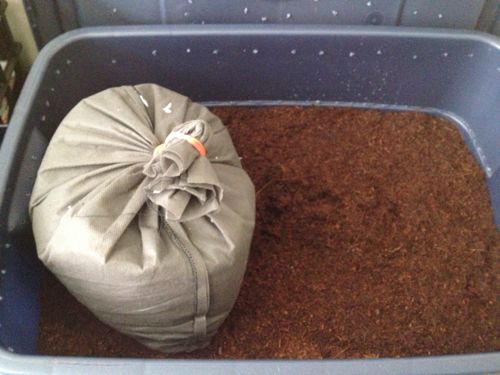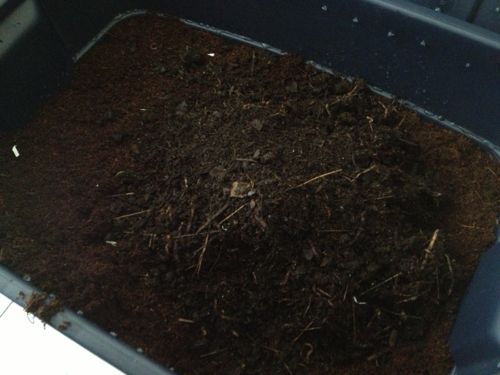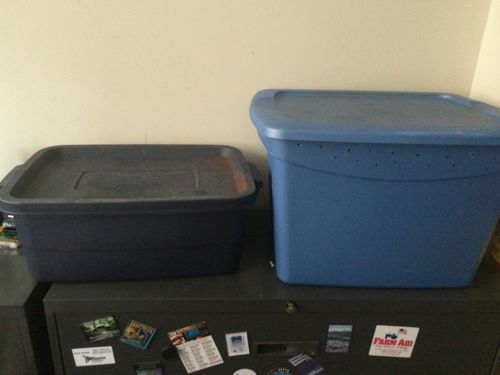One Year of Vermicomposting
When I had a yard I’d compost yard waste and occasionally, kitchen scraps. When I moved into a downtown loft with a 5×10 balcony 6+ years ago I thought my composting days were over. I knew of using worms to compost, but I’d never tried it.
One year ago today we started our worm bin — vermicomposting — indoors.
Vermicompost is the product or process of composting using various worms, usually red wigglers, white worms, and other earthworms to create a heterogeneous mixture of decomposing vegetable or food waste, bedding materials, and vermicast. Vermicast, also called worm castings, worm humus or worm manure, is the end-product of the breakdown of organic matter by an earthworm. These castings have been shown to contain reduced levels of contaminants and a higher saturation of nutrients than do organic materials before vermicomposting.
Containing water-soluble nutrients, vermicompost is an excellent, nutrient-rich organic fertilizer and soil conditioner. This process of producing vermicompost is called vermicomposting. (Wikipedia)
I was very excited to be starting the bin:


In the last year I made many mistakes; the bin got too wet, too dry, etc. I added a second bin and have finally found a balance.
Nearly every kitchen scrap gets composted. I was trying to add citrus peels but doing so threw off the PH level, even in small amounts. I’ve found other uses for lemon & orange peels, like scenting vinegar to use for cleaning.

Does this take time? Yes, but it also feels good to not put waste down the disposal or into a landfill. The castings are great for our potted plants — both indoors and those on our balcony.
— Steve Patterson
Where did you buy your worms? I checked online and looks like about $40 a pound. Hoping able to purchase some locally or maybe someone is willing to share
I got mine online, a local bait shop might have some.
Here are a few links, you should be able to find a 1000 red worms for around $20.
http://www.vermica.com/vermiculture_resources/vermiculture_resources_usa_10a.htm#Missouri
and also
http://www.dnr.mo.gov/env/swmp/worms/wormsources.htm
although the dnr website seems to have outdated links. check the redworms link
A great book is Earthworms for ecology and profit, by Ronald Gaddie, goes into detail about raising earthworms and excellent info about the biology and life of the earthworm, although the vermiculture website mentioned above has a good deal of info.
I used to see ads for earthworms in the Curive River Electric coop magazine “Rural Missouri” which you can look at on their website. (link on the upper right side of the web page)
http://www.cuivre.com/
I checked this months issue and there were no ads, but if you follow it I remember seeing ads for earthworms a fair amount of the time. This issue has a yearly “Best of Missouri” section which is always interesting. I think “Small Farm Journal”, published in Missouri, also has had ads for worms, I went to their website but couldn’t look at ads. World News in Clayton used to carry copies of Small Farm Journal, I’d call first though if you want to look at the magazine to make sure they still carry it.
Yeah so in the 70’s I owned a few buildings in Soulard with dirt floors in the basement and dug about a 15 foot long pit a couple of feet wide in the hard clay, made a great place to raise earthworms and I was able to create numerous environments within the pit which helped take care of some of the problems Steve is talking about.
Also check out uncle jims worm farm, they too are 20 bucks for a 1000 redworms
http://unclejimswormfarm.com/
I had a great garden in Soulard. Still do gardening but just fed worms by digging holes out in the garden and filling with whatever I think they would like to eat. I throw a heavy stone on top to keep out critters and use only veggie waste. I especially save all of my coffee and tea grounds.